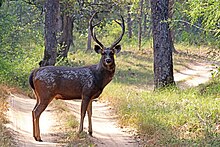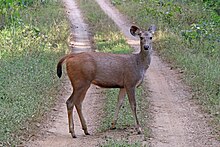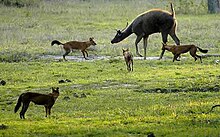Sambar deer
| Sambar | |
|---|---|

| |
| Stag | |

| |
| Hind both R. u. unicolor in Kanha National Park, Madhya Pradesh, India
| |
| Scientific classification | |
| Domain: | Eukaryota |
| Kingdom: | Animalia |
| Phylum: | Chordata |
| Class: | Mammalia |
| Order: | Artiodactyla |
| Family: | Cervidae |
| Subfamily: | Cervinae |
| Genus: | Rusa |
| Species: | R. unicolor
|
| Binomial name | |
| Rusa unicolor (Kerr, 1792)
| |

| |
| Range of the sambar | |
| Synonyms | |
| |
The sambar (Rusa unicolor) is a large deer native to the Indian subcontinent, South China and Southeast Asia that is listed as a vulnerable species on the IUCN Red List since 2008. Populations have declined substantially due to severe hunting, local insurgency, and industrial exploitation of habitat.[1]
The name "sambar" is also sometimes used to refer to the Philippine deer called the "Philippine sambar", and the Javan rusa called the "Sunda sambar".
Taxonomy and evolution

Genetic analysis shows that the closest living relative of the sambar is most likely the Javan rusa of Indonesia.[2] This is supported by reports that sambar can still interbreed to produce fertile hybrids with this species.[3]
Fossil sambar are known from the early Pleistocene, although they are very similar in form to early deer species from the Pliocene, with less of a resemblance to more modern cervines. The species probably arose in the tropical reaches of southern Asia, and later spread across its current range. Epirusa and Eucladoceros have both been proposed as possible ancestors of the living species and its closest relatives.[3][4]
Subspecies
The
Currently, seven subspecies of sambar are recognised,[3][5] although many others have been proposed.
| Subspecies | Common name | Geographic range |
|---|---|---|
R. u. unicolor
|
Sri Lankan sambar | India, Bangladesh, Sri Lanka |
| R. u. brookei | Bornean sambar | Borneo |
R. u. cambojensis
|
Mainland Southeast Asian sambar | Mainland Southeast Asia |
| R. u. dejeani | South China sambar | Southern and southwestern China |
R. u. equina
|
Malayan sambar | Sumatra |
| R. u. hainana | Hainan sambar | China (Hainan) |
R. u. swinhoii
|
Formosan sambar | Taiwan |
| ↑R. u. boninensis[6] | Bonin sambar | Extinct; Japan (Bonin Islands) |
Description

The appearance and the size of the sambar vary widely across its range, which has led to considerable taxonomic confusion in the past; over 40 different scientific synonyms have been used for the species. In general, they attain a height of 102 to 160 cm (40 to 63 in) at the shoulder and may weigh as much as 546 kg (1,204 lb), though more typically 100 to 350 kg (220 to 770 lb).[7][8] Head and body length varies from 1.62 to 2.7 m (5.3 to 8.9 ft), with a 22 to 35 cm (8.7 to 13.8 in) tail.[9] Individuals belonging to western subspecies tend to be larger than those from the east, and females are smaller than males.[3] Among all living cervid species, only the moose and the elk can attain larger sizes.[10]
The large, rugged antlers are typically rusine, the brow tines being simple and the beams forked at the tip, so they have only three tines. The antlers are typically up to 110 cm (43 in) long in fully adult individuals. As with most deer, only the males have antlers.[3]
The shaggy coat can be from yellowish brown to dark grey in colour, and while it is usually uniform in colour, some subspecies have chestnut marks on the rump and underparts. Sambar also have a small but dense mane, which tends to be more prominent in males. The tail is relatively long for deer, and is generally black above with a whitish underside.[3]
Adult males and pregnant or lactating females possess an unusual hairless, blood-red spot located about halfway down the underside of their throats. This sometimes oozes a white liquid, and is apparently glandular in nature.[11]
Distribution and habitat
The sambar is distributed in much of
The sambar prefers the dense cover of deciduous shrubs and grasses,[11] although the exact nature of this varies enormously with the environment because of its wide Asian range. Home range sizes are probably equally variable, but have been recorded as 1,500 ha (3,700 acres) for males and 300 ha (740 acres) for females in India.[3]
Ecology and behaviour



Sambar are nocturnal or
Sambar feed on a wide variety of vegetation, including grasses, foliage, browse, fruit, and water plants, depending on the local habitat.[11] They also consume a great variety of shrubs and trees.[3]
Sambar have been seen congregating in large herds in protected areas such as national parks and reserves in India, Sri Lanka, and Thailand. In Taiwan, sambar along with
Stags wallow and dig their antlers in urine-soaked soil, and then rub against tree trunks.[11] Sambar are capable of remarkable bipedalism for a deer species, and stags stand and mark tree branches above them with their antlers.[14] A stag also marks himself by spraying urine on his own face with a highly mobile penis.[11] Despite their lack of antlers, female sambar readily defend their young from most predators, which is relatively unusual among deer. When confronted by pack-hunting dholes or feral domestic dogs, a sambar lowers its head with an erect mane and lashes at the dogs. Sambar prefer to attack predators in shallow water. Several sambar may form a defensive formation, touching rumps and vocalising loudly at the dogs.[11] When sensing danger, a sambar stamps its feet and makes a ringing call known as "pooking" or "belling".[14]
They are the favourite prey of tigers and Asiatic lions. In India, the sambar can comprise up to nearly 45% of the biomass consumed by the Bengal tiger.[15] Anecdotally, the tiger is said to even mimic the call of the sambar to deceive it while hunting.[16] They also can be taken by crocodiles, mostly the sympatric mugger crocodiles and saltwater crocodiles. Leopards and dholes largely prey on only young or sickly deer, though they can attack healthy adults as well.[1]
Reproduction
Though they mate and reproduce year-round, sambar calving peaks seasonally.

Courtship is based more on tending bonds rather than males vocally advertising themselves.

Gestation probably lasts around 8 months, although some studies suggest it may be slightly longer. Normally, only one calf is born at a time, although twins have been reported in up to 2% of births. Initially weighing 5 to 8 kg (11 to 18 lb), the calves are usually not spotted, although some subspecies have light spots which disappear not long after birth.[3] The young begin to take solid food at 5 to 14 days, and begin to ruminate after one month.[17] Sambar have lived up to 28 years in captivity, although they rarely survive more than 12 years in the wild.[3]
As an introduced species
Sambar have been introduced to various parts of the world, including Australia, New Zealand and the United States.[18]
Australia
In Australia, hunting sambar is a popular sport. Australian hunting fraternities prize large sambar trophies.[19] Excessive numbers of sambar affect native plants, threatening some species with extinction.
Sambar were introduced into
In
Adult male sambar can significantly damage plants, removing most branches on some shrubs and sometimes girdling trees by thrashing their antlers on shrubs and sapling trees. They also feed on seedlings, fruit, or seeds of many plants. They leave scrape marks to advertise their territory.[24]
The spread of sambar has been steady in both
Considerable debate exists about how they should be managed. Conservation groups believe their environmental effect outweighs their social value. Hunting organisations disagree and want to preserve sambar populations for future generations. Sambar are protected wildlife game species in Victoria and New South Wales, and a game licence is required to hunt them. In Victoria, recent provisions have been made for landowners to control problem deer without having to obtain a Game Licence or Authority to Control Wildlife permit.[25] This allows a landowner or other authorised persons to remove problem deer within private property at any time and are permitted to hunt under spotlight, which is prohibited on public land. They are declared a pest species in all other Australian states and territories and can be hunted at any time with no bag limits. Environmental and conservation groups want them declared a feral species in all states, due to their exploding populations and the harm to biodiversity and native species.
In 2008–2009, hunters removed 35,000 sambar from public land in Victoria, many from national parks. This is a small fraction of the 40% of individuals in a sambar population that need to be removed to stop population growth.[26]
New Zealand
In
United States
Sambar were introduced onto St. Vincent Island, Florida, in 1908[28] and increased to about 50 individuals by the 1950s. White-tailed deer also live on St. Vincent Island; however, they inhabit the highlands while the sambar mostly live in the lowlands and marshes. To ensure that the sambar population does not disrupt the native white-tails, hunting permits have been issued since 1987 to regulate the population.[29] Each year, about 130 permits are offered for the three-day hunt. This maintains a sambar population of 70–100 individuals.[30] They do not herd, but occur in groups of four or five animals, possible family groups. Little is known about the sambar's ecology in Florida.[31]
Between 1930 and 1941, Sambar were brought to the US state of Texas along with other imported big game that are referred to as exotic game.[32] 76% of fenced exotics are found on the Edwards Plateau, whereas 59% of free range exotics are found in South Texas.[33]
See also
References
- ^ . Retrieved 19 February 2022.
- PMID 8340615.
- ^ doi:10.1644/871.1.
- PMID 27667928.)
{{cite journal}}: CS1 maint: multiple names: authors list (link - OCLC 62265494.
- .
- ISBN 0789477645
- ^ "Comparative Placentation". Placentation.ucsd.edu. Retrieved 17 August 2012.
- ISBN 978-0-671-42805-1
- ^ "Deer – Department of Primary Industries". Dpi.vic.gov.au. 3 January 2012. Retrieved 17 August 2012.
- ^ a b c d e f g h i Geist, V. (1998). Deer of the world: their evolution, behaviour, and ecology. Mechanicsburg: Stackpole Books. pp. 73–77.
- ^ "Sambar deer making a return in Singapore, study shows | The Straits Times". www.straitstimes.com. 27 February 2023. Retrieved 27 February 2023.
- ^ "Handle Materials". The Knife Connection. Archived from the original on 5 March 2012. Retrieved 11 March 2012.
- ^ a b c d Schaller, G. (1967). The Deer and the Tiger: A Study of Wildlife in India. Chicago: University Of Chicago Press. pp. 134–148.
- .
- ^ Perry, R. (1965). The World of the Tiger. p. 260. ASIN B0007DU2IU
- S2CID 85944078.
- ISBN 9780851997483
- ISBN 978-0959343892.
- ^ "Sambar Deer (Rusa unicolor)". Australian Deer Association. 2017. Retrieved 19 January 2017.
- ^ Cattermole, Tony (31 March 2015). "Deer hunters work to control sambar deer numbers in Victoria's Alpine National Park". ABC News. Goulburn Murray. Retrieved 18 July 2017.
- ISBN 978-0724116898.
- ^ "Flora and Fauna Guarantee Act 1988 processes list" (PDF). Department of Environment, Land, Water and Planning. State Government of Victoria. December 2016. Retrieved 18 January 2017.
- ^ "New plan needed to manage impact of Sambar deer" (Press release). OpenDocument Media Release. Melbourne, Australia: Minister for Environment & Climate Change. 28 November 2007.
- ^ "Control of deer on private property" (PDF). Melbourne, Australia: Game Management Authority. 2018.
- ^ Hone, J.; Duncan, R.P.; Forsyth, D.M. (2010). "Estimates of maximum annual population growth rates (rm) of mammals and their application in wildlife management". Journal of Applied Ecology. 47 (3): 507–514. .
- ^ Deer: DOC's work. Department of Conservation (date=20 November 2013)
- ^ "Sambar Deer – Cervus unicolor". Florida Fish and Wildlife Conservation Commission.
- ^ "St Vincent Sambar Deer". Florida Fish And Wildlife Conservation Commission. Retrieved 27 February 2023.
- ^ Henry Cabbage (May–June 2006). "Going after 600-pound sambar deer in Florida!" (PDF). Florida Wildlife Magazine: 39–41. Archived from the original (PDF) on 20 March 2009.
- ISBN 0-679-44631-1.
- ^ "Exotic and Fur-bearing Species". Texas Parks and Wildlife.
- ^ Olivera, Andy (12 September 2018). "Hunting Texas Exotics a Year-Round Opportunity". Game & Fish. Game & Fish Mag: A Regional Outdoor Guide. Retrieved 29 December 2021.

